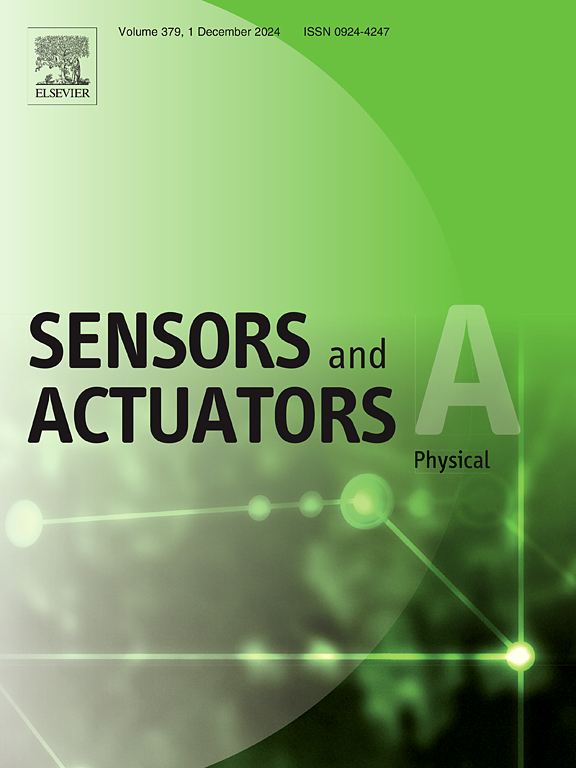Nanoarchstructured MoS2-based strain sensor with exceptional gauge factor
IF 4.1
3区 工程技术
Q2 ENGINEERING, ELECTRICAL & ELECTRONIC
引用次数: 0
Abstract
Two-dimensional (2D) MoS2, part of the transition metal dichalcogenides family, has emerged as a promising candidate for wearable strain sensors owing to its unique attributes, including mechanical flexibility, low toxicity, tunable and high electrical properties. MoS2-based sensors exhibit higher gauge factors (∼760 for monocrystalline, ∼56.5 for polycrystalline) and a lower limit of detection than conventional metal sensors. We report an advanced strain sensor with ultra-high sensitivity to minute deformations, exploiting a three-dimensional nanostructured-2D MoS2 (3DN-MoS2) with an arch-like configuration. The nanoarchstructured MoS2-based strain sensor (NaM-SS) achieves exceptional gauge factors, exceeding 1500 for tensile strain, using 3DN-MoS2 sensing material in conjunction with a poly-dimethylsiloxane support. This piezo-resistive sensor, fabricated through an eco-friendly and straightforward process, exhibits remarkable gauge factors at three levels: 1500 (ε < 0.55 %), 13,500 (0.55 %< ε ≤ 0.75 %), and 37,000 (0.75 % < ε ≤ 1.2 %). The sensor’s limit of detection stands at a subtle tensile strain ε of 0.02 %. Furthermore, its feasibility is validated by its ability to monitor various human physical motions, including eye blinking, blood pulsation, and muscle activity. Our findings indicate significant potential for precision strain sensors in applications requiring ultra-high sensitivity, such as detecting subtle biomedical signals, meticulous machinery control, and structural health monitoring.
基于纳米拱形结构 MoS2 的应变传感器具有优异的测量系数
二维(2D)MoS2 属于过渡金属二钙化族,由于其独特的属性,包括机械灵活性、低毒性、可调性和高电性能,已成为可穿戴应变传感器的理想候选材料。与传统金属传感器相比,基于 MoS2 的传感器具有更高的测量系数(单晶为 760,多晶为 56.5)和更低的检测限。我们报告了一种对微小变形具有超高灵敏度的先进应变传感器,它利用了具有拱形结构的三维纳米结构二维 MoS2(3DN-MoS2)。这种基于纳米拱形结构 MoS2 的应变传感器(NaM-SS)使用 3DN-MoS2 传感材料和聚二甲基硅氧烷支撑物,实现了超高的测量系数,拉伸应变测量系数超过 1500。这种压阻式传感器采用环保、简便的工艺制作而成,在三个水平上表现出卓越的测量系数:1500(ε < 0.55 %)、13500(0.55 % < ε ≤ 0.75 %)和 37000(0.75 % < ε ≤ 1.2 %)。传感器的检测极限为 0.02 % 的微小拉伸应变 ε。此外,它还能监测各种人体物理运动,包括眨眼、血液脉动和肌肉活动,从而验证了其可行性。我们的研究结果表明,精密应变传感器在需要超高灵敏度的应用中具有巨大潜力,例如检测微妙的生物医学信号、精细机械控制和结构健康监测。
本文章由计算机程序翻译,如有差异,请以英文原文为准。
求助全文
约1分钟内获得全文
求助全文
来源期刊

Sensors and Actuators A-physical
工程技术-工程:电子与电气
CiteScore
8.10
自引率
6.50%
发文量
630
审稿时长
49 days
期刊介绍:
Sensors and Actuators A: Physical brings together multidisciplinary interests in one journal entirely devoted to disseminating information on all aspects of research and development of solid-state devices for transducing physical signals. Sensors and Actuators A: Physical regularly publishes original papers, letters to the Editors and from time to time invited review articles within the following device areas:
• Fundamentals and Physics, such as: classification of effects, physical effects, measurement theory, modelling of sensors, measurement standards, measurement errors, units and constants, time and frequency measurement. Modeling papers should bring new modeling techniques to the field and be supported by experimental results.
• Materials and their Processing, such as: piezoelectric materials, polymers, metal oxides, III-V and II-VI semiconductors, thick and thin films, optical glass fibres, amorphous, polycrystalline and monocrystalline silicon.
• Optoelectronic sensors, such as: photovoltaic diodes, photoconductors, photodiodes, phototransistors, positron-sensitive photodetectors, optoisolators, photodiode arrays, charge-coupled devices, light-emitting diodes, injection lasers and liquid-crystal displays.
• Mechanical sensors, such as: metallic, thin-film and semiconductor strain gauges, diffused silicon pressure sensors, silicon accelerometers, solid-state displacement transducers, piezo junction devices, piezoelectric field-effect transducers (PiFETs), tunnel-diode strain sensors, surface acoustic wave devices, silicon micromechanical switches, solid-state flow meters and electronic flow controllers.
Etc...
 求助内容:
求助内容: 应助结果提醒方式:
应助结果提醒方式:


